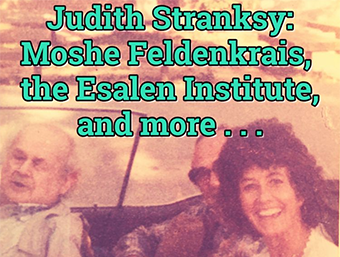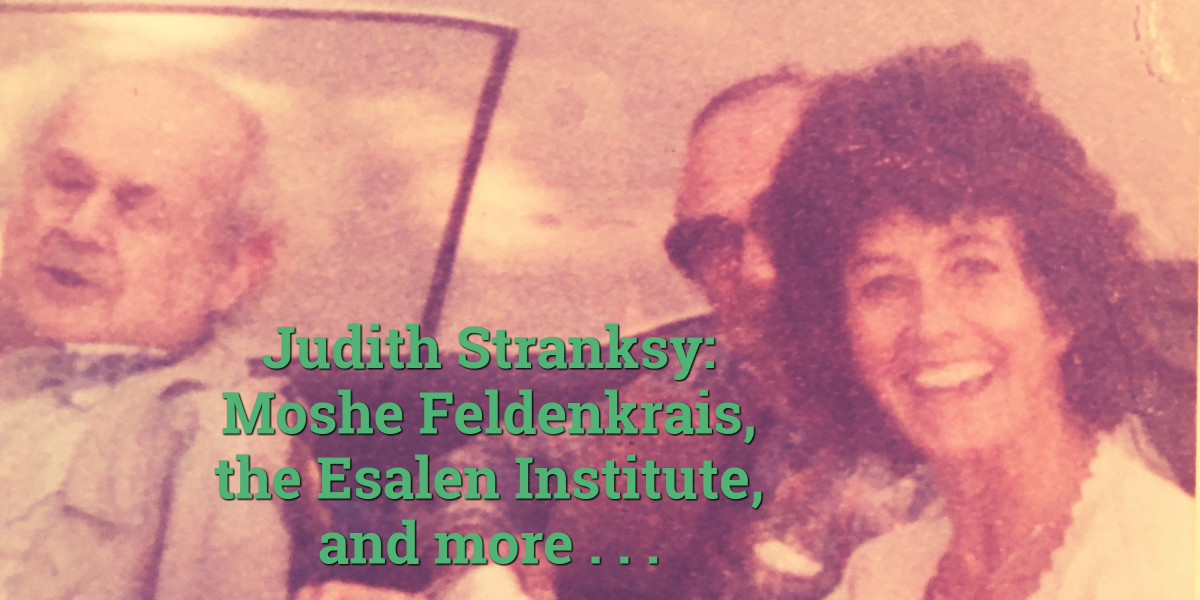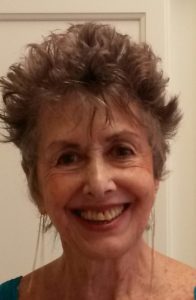
Judith Stransky

Recently I had the great pleasure to talk with the delightful Judith Stransky about her experience studying with Moshe Feldenkrais when he first came to the United States.
 Judith, who is both an Alexander teacher and a certified Awareness Through MovementⓇ teacher, is one of the unsung heroes in the history of Moshe’s method. The transcripts of the ATMⓇ lessons that Dr. Feldenkrais taught at the Esalen Institute in 1972 are among the fundamental texts of the method, used by teachers and in FeldenkraisⓇ teacher trainings the world over.
Judith, who is both an Alexander teacher and a certified Awareness Through MovementⓇ teacher, is one of the unsung heroes in the history of Moshe’s method. The transcripts of the ATMⓇ lessons that Dr. Feldenkrais taught at the Esalen Institute in 1972 are among the fundamental texts of the method, used by teachers and in FeldenkraisⓇ teacher trainings the world over.
Our wide-ranging conversation spanned the decades from Judith’s introduction to the method in Israel to the last time she saw Moshe. I was delighted by her down-to-earth and insightful. Even better, at almost every turn, as she provided the kind of details that only someone who had been there would know, I learned something new about how the method and how it developed. For instance, she clarified the true nature of the course at Esalen, which, up until that moment, I’d mistakenly referred to as a “workshop.” (It was, in terms of its promotion, intent, and outcome, a training for ATM teachers.) Recounting what Moshe taught and how he taught, she let’s us in on what happened, behind the scenes, between the participants and Moshe, revealing how the terms for the method came to be and so much more.
 I invite you to listen to my 59 minute and 59 second interview with Judith. You can stream interview on any Internet-enabled device of your choosing or you can download it for later.
I invite you to listen to my 59 minute and 59 second interview with Judith. You can stream interview on any Internet-enabled device of your choosing or you can download it for later.
Your thoughts?
Please let us know your perspective! Add your comments, reactions, suggestions, ideas, etc., by first logging in to your Mind in Motion account and then clicking here.
Commenting is only available to the Mind in Motion Online community.
Join in by getting your free account, which gives you access to the e-book edition of Articulating Changes (Larry's now-classic Master's thesis), ATM® lessons, and more — all at no charge whatsoever.
To find out more and sign up, please click here.
Please share this blog post
 This work is licensed under a Creative Commons Attribution-ShareAlike 4.0 International License
This work is licensed under a Creative Commons Attribution-ShareAlike 4.0 International License
This blog may contain one or more affiliate links. When you click on a link and then make a purchase, Mind in Motion receives a payment. Please note that we only link to products we believe in and services that we support. You can learn more about how affiliate links work and why we use them here


Link for audio not working (((
Thanks for letting me know, Nick!
The link was fixed right after you informed me and it’s now working.
Dear Larry, thank you for this interview. It was very interesting to hear Judith Stransky’s recollections of this important five week ATM training program. I could have heard her for 59 more minutes…
What a great interview! Thank you so much, Larry, for sharing that with us. I love to learn about the context of those training programs. Reading a transcript I’m always wondering how many people there was, how the classrooms looked like, how intense the program was, how nice or close to the students Moshe was. I truly enjoyed listening to her. Thank you!
Hello Myriam –
Glad you enjoyed the interview! It happened because I had the same questions about Moshe’s first iteration of an ATM-only training and because Judith is such a gracious colleague.
So interesting to hear!
It sure is!
Thanks for reposting the link to this wonderful interview!
(although the busy mouse-clicking and typing noises are a bit distracting, I am afraid)
It seemed like Judith Stransky really liked to talk about this time and she seemed to be prepared to continue for a while. What a pity that the interview could only last one hour.
We are lucky that the IFF could publish the recordings of the all the ATMs of that seminar and we are no longer left with the excerpt of the Big Sur recordings.
For the uninitiated and curious, here are some notes on the illustrous group of participants (to the best of my knowledge).
Recommended background reading: Walter Truett Anderson 1983/2004 The Upstart Spring – Esalen and the Human Potential Movement
– Stanley Keleman: in the US next to Alexander Lowen / John Pierrakos and Charles Kelley the major exponent of “Bioenergetics” in a very generic sense. His book “Emotional Anatomy” became a classic.
The Rolfers
– Will Schutz therapist in residence in Esalen, famous for his encounter group work.
– Dub Leigh, one of two Rolfers who joined Feldenkrais’ San Francisco training program. Later he was trained by Tanouye Roshi in Zen and Bodywork and taught his own style of Structural Integration: “Zen Bodytherapy”.
– Seymour Carter became part of the Esalen crew rather early, trained with Fritz Perls to become a Gestalt-Therapist, with Ida Rolf to become a Rolfer and dove deep into the work of Charlotte Selver. He lead groups in Sensory Awareness and Gestalt in the US, Germany and Eastern Europe.
– Judith Aston trained as a Rolfer and Dr. Rolf asked her to develop a curriculum in movement work for Rolfers. This became the foundation for “Rolfing Movement Integration” while Judith Aston eventually went on to create her own work “Aston Patterning”.
The Alexander Teachers
– Frank Ottiwell was trained in the Alexander Technique by Judith Leibowitz with whom he founded the AmSTAT. He also was a disciple of Charlotte Selver.
– Ilana Rubenfeld, trained in the Alexander-Technique, Gestalt-Therapy and the Feldenkrais-Method, which she synthesized into her own approach “Rubenfeld Synergy”.
– Judith Stransky
– Betty Fuller, actor, was at that time part of the Esalen crew. A few years later she found her new vocation in the work of Milton Trager. She became co-founder and first director of the Trager institute and was instrumental in the development of its curriculum.
The guy whose name Judith Stransky remembered as “Downy” or “Downing” might have been
either
– George Downing wrote the famous “The Massage Book” which was published in the same year as the Esalen Workshop. In later years Downing became a leading figure in bodypsychotherapy in Europe and wrote another book “The Body and the Word” 1994.
or
– Jack Downing, who collaborated with Julian Silverman in researching non-medication interventions addressing psychotic episodes.
– Dick Price founded Esalen together with Michael Murphy. He died 1985 in a tragic accident on a hike. According to Seymour Carter, it was a big loss for Esalen, especially as he represented the more politically and socially interested half of the two.
If Judith Stransky is still available (I could not find her in the www) it would be great if she could figure out
– who the European lady from San Diego was who taught body movement?
– and who the one person whose name Judith Stransky could not remember was?
Hello Claudius –
Thank you so much for your fascinating and detailed response.
Yes, it is wonderful that the International Feldenkrais Federation has made the entire set of Esalen workshop recordings available.
I appreciate you providing so much background on the participants in the course.
Hello Claudius, hello Larry,
I think I can help with the name of the guy whose name Judith couldn’t remember. His name is Ian J. Grand. He wrote an article about the Esalen Workshop which is published on the Esalen Website:
https://www.esalen.org/ctr-journal/feldenkrais-at-esalen
Hope his reminiscences help to complete the picture about this very important workshop in the development of the Feldenkrais Method.
Thanks Larry for doing the interview with Judith and making it available to the public.
Thank you, Claus.
It was a such a pleasure to talk with Judith. I’m honored to have had the opportunity to contribute to the history of Moshe’s method.
I appreciate you pointing us to Ian Grand’s wonderful article about the 1972 Esalen workshop.